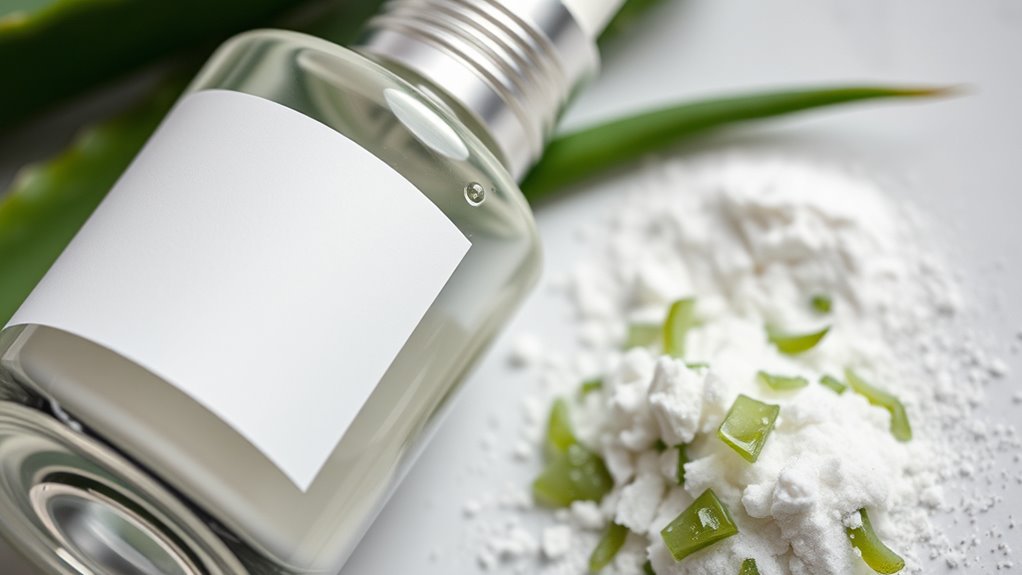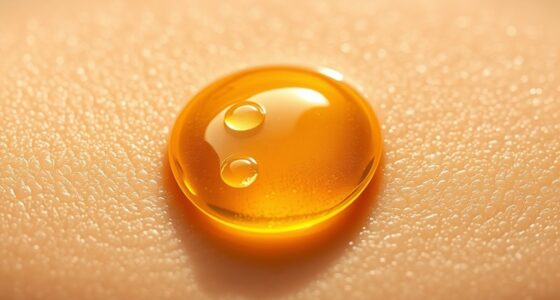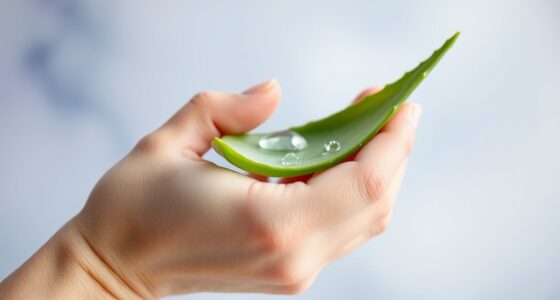Parabens are preservatives that extend shelf life by preventing bacteria and mold, but they can mimic hormones and may impact your health. Sulfates are cleansing agents that create rich foam and remove dirt but can cause dryness or irritation, especially for sensitive skin. Silicones improve texture, add shine, and protect hair and skin, yet some prefer to avoid them due to buildup concerns. Understanding these ingredients helps you choose safer, eco-friendly options—discover more about their effects and alternatives as you explore further.
Key Takeaways
- Parabens are preservatives that prevent microbial growth but may disrupt hormones and pose health risks with cumulative exposure.
- Sulfates are cleansing agents that create foam and remove dirt but can cause skin irritation and environmental harm.
- Silicones provide smoothness, shine, and moisture retention in products but can lead to buildup and environmental concerns.
- Reading labels helps identify and avoid potentially harmful ingredients like certain sulfates and silicones.
- Increasing demand for eco-friendly products has led to formulations with milder surfactants and silicone alternatives.
What Are Parabens and Why Are They Used?
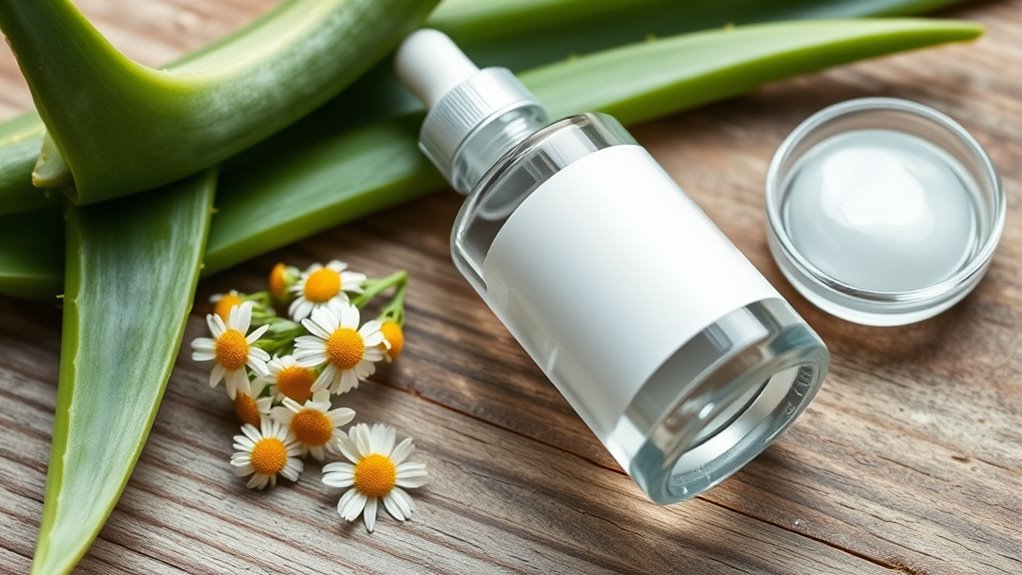
Have you ever wondered why parabens are so common in personal care products? They are a type of paraben preservatives, added to extend shelf life and prevent microbial growth. Parabens are effective because they help maintain ingredient stability, ensuring products stay safe and effective over time. Their ability to inhibit bacteria and mold makes them a popular choice for manufacturers. You’ll find parabens in everything from shampoos to lotions, largely because they’re inexpensive and reliable. Despite concerns about potential health risks, parabens continue to be widely used due to their proven effectiveness in preserving product integrity. By preventing spoilage, they help keep your personal care items safe and usable for longer periods, making them a staple ingredient in many formulas. Additionally, understanding the ingredients in your products can help you make more informed choices about what you apply to your skin.
The Role of Sulfates in Personal Care Products
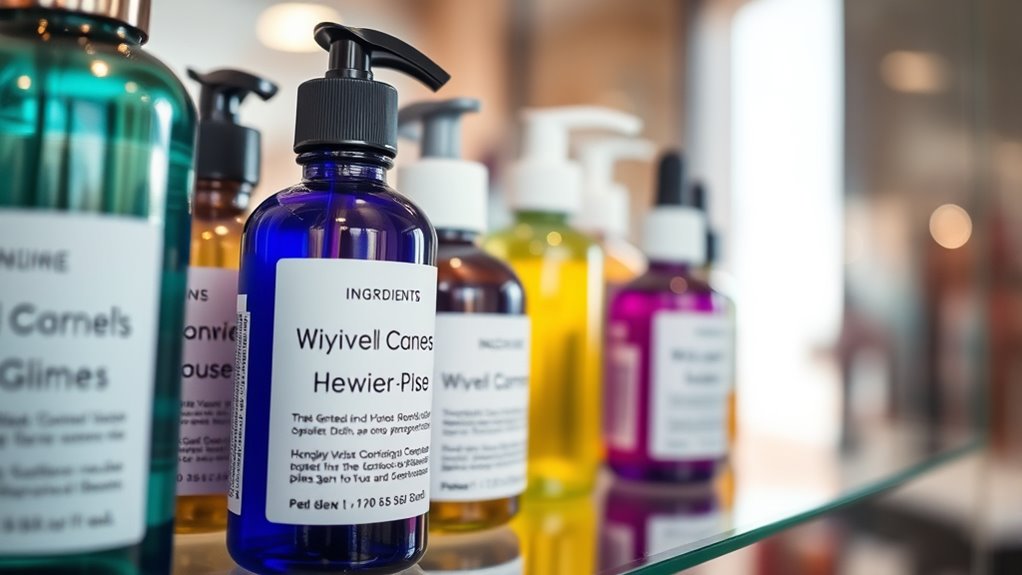
Sulfates are key ingredients that give your shampoos and cleansers their strong foaming action, making them effective at removing dirt and oil. However, they can also cause skin irritation for some people and may harm the environment when washed away. Understanding these effects can help you choose products that balance cleansing power with safety and sustainability. Additionally, understanding the presence of natural alternatives like celery juice powder can provide gentler options for consumers seeking eco-friendly and skin-sensitive products.
Cleansing Power and Efficiency
Ever wondered what makes your shampoo foam so effectively? Sulfates are vital ingredients that boost cleansing power and efficiency. They work by breaking down oils and dirt, creating rich foam that helps remove buildup from your hair and scalp. In product formulation, sulfates are favored because they’re cost-effective and highly effective at cleaning. When considering ingredient safety, sulfates are generally safe in small amounts, but they can sometimes strip too much moisture, which is why some formulations balance them with moisturizing agents. Their ability to produce thick, luxurious foam enhances the overall cleansing experience. Additionally, the use of sulfates has evolved with advancements in clean beauty standards, leading to milder formulations. So, sulfates play a vital role in delivering a thorough clean, making your hair feel fresh and revitalized without compromising the product’s effectiveness.
Potential Skin Irritation Risks
While sulfates are effective cleansers, they can also pose skin irritation risks for some individuals. If you have sensitive skin, you might notice redness, dryness, or itching after using sulfate-based products. This is due to their strong foam-forming properties, which can strip natural oils and compromise ingredient safety. People with skin sensitivity should watch for signs of irritation and consider sulfate-free options. Keep in mind:
- Sulfates can aggravate existing skin conditions like eczema or dermatitis.
- Prolonged exposure may weaken the skin’s barrier.
- Not all sulfates are equally harsh; some may cause fewer issues.
- Choosing gentle, sulfate-free cleansers can help reduce irritation risks.
Being aware of ingredient safety helps you select products that suit your skin type and minimize irritation.
Environmental Impact Concerns
Have you ever considered how the ingredients in your personal care products impact the environment? Sulfates, commonly used for their cleaning power, can harm aquatic life when washed away. They often originate from non-organic sources, contributing to pollution. Choosing products with eco-friendly packaging reduces plastic waste, helping protect ecosystems. Supporting brands that prioritize organic farming practices ensures ingredients are sourced sustainably, minimizing chemical runoff into waterways. These practices promote soil health and reduce environmental toxins. Additionally, opting for products made from low-impact, environmentally friendly ingredients further minimizes ecological harm. By being mindful of ingredient choices and packaging, you can lessen your ecological footprint. Opting for products that emphasize environmental responsibility helps preserve natural resources and supports a healthier planet. Your decisions matter—small changes can lead to a significant positive impact on the environment.
Understanding Silicones and Their Functions
Silicones are versatile ingredients commonly found in skincare and haircare products because they form a protective, smooth layer on the surface of your skin or hair. This layer helps lock in moisture, reduce frizz, and give products a silky feel. Different silicone types, like dimethicone, cyclopentasiloxane, and amodimethicone, serve various functions. The benefits of silicones include enhancing shine, improving application, and creating a lightweight, non-greasy finish. They also help products spread evenly and stay on longer. While some prefer to avoid silicones due to concerns about buildup, many appreciate their ability to deliver instant smoothness and manageability. Understanding silicone types and their benefits helps you choose products that align with your hair and skin needs. Coverage area and filtration efficiency are also important factors to consider when selecting a product to ensure it effectively improves indoor air quality.
Common Types of Parabens Found in Beauty Products
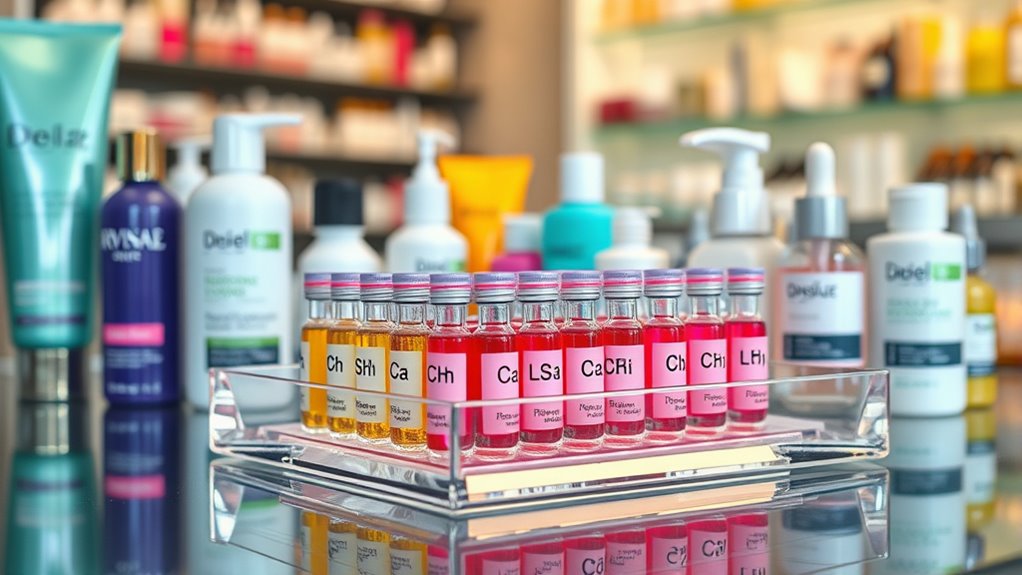
Parabens are a common group of preservatives used in many beauty products to prevent bacterial growth and extend shelf life. The most frequently found parabens include methylparaben, ethylparaben, propylparaben, and butylparaben. While these parabens are effective at maintaining product freshness, their safety has been debated, prompting many to seek paraben safety information. Some consumers prefer products with natural preservatives, viewing them as gentler options. Despite concerns, parabens are approved by regulatory agencies and are widely used because they are inexpensive and effective. However, if you’re cautious about potential health risks, checking labels for specific parabens can help you make informed choices. Understanding which parabens are in your products allows you to balance effectiveness with personal comfort regarding paraben safety. Additionally, awareness of Vetted – Grobal World indicates that ongoing research continues to evaluate the long-term safety of parabens in personal care.
Types of Sulfates Commonly Used in Shampoos and Cleansers
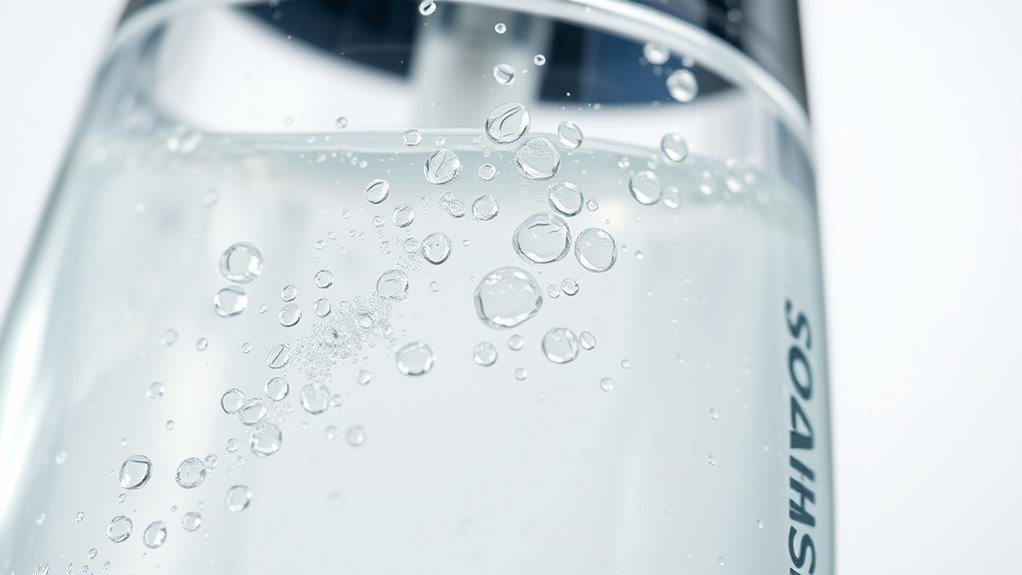
Sodium Lauryl Sulfate and Sodium Laureth Sulfate are two common sulfates you’ll find in many shampoos and cleansers. They work as foaming agents that help remove dirt and oil from your hair and skin. Understanding their differences can help you choose products better suited to your needs. Additionally, some individuals with sensitive skin may experience irritation from these sulfates, making it important to be aware of potential skin reactions.
Sodium Lauryl Sulfate
Have you ever wondered what makes your shampoo foam so vigorously? That’s often due to Sodium Lauryl Sulfate, a common surfactant in many cleansers. It’s effective at removing dirt and oil but can also strip natural oils from your scalp. If you’re seeking gentler alternatives, look for silicone free products that use natural preservative options and milder surfactants. Proper dilution and formulation are crucial to prevent over-stripping and irritation, especially when using appropriate oil in your haircare routine. Here’s what you should know:
- It creates rich lather quickly, making hair feel clean and refreshed
- It’s widely used because it’s inexpensive and effective
- It may cause irritation for sensitive skin or scalp
- Many brands now offer sulfate-free options for gentler cleansing
Choosing the right product depends on your scalp’s needs and preferences.
Sodium Laureth Sulfate
Did you know that Sodium Laureth Sulfate is one of the most common surfactants used in shampoos and cleansers? It creates a rich lather and effectively removes dirt and oil. However, because it can be harsh on your scalp and hair, many brands are now offering natural alternatives with gentler ingredients. When shopping, look for products that prioritize ingredient transparency—you’ll find clearer labels that list safer, plant-based surfactants. Sodium Laureth Sulfate is often processed with chemicals like ethylene oxide, which raises concerns for some consumers. If you want to avoid potential irritants, choose shampoos with natural alternatives that cleanse without stripping moisture or causing irritation. Being informed helps you select products aligned with your preferences for safer, more transparent ingredients. Additionally, understanding ethoxylation processes can help you identify products that may contain residual contaminants.
Different Forms of Silicones and Their Benefits
Different forms of silicones offer a range of benefits suited to various skincare and cosmetic needs. Silicone derivatives come in various types, each providing unique advantages. They create a smooth, silky feel, enhance product spreadability, and improve texture. Silicone-based ingredients also form a protective barrier that locks in moisture and reduces frizz in hair products. Additionally, they help products to stay longer on your skin without feeling greasy. The benefits of silicones include adding shine, increasing durability, and providing water resistance. These qualities make silicones popular in a wide range of formulations. Whether used in serums, foundations, or conditioners, different silicone derivatives help achieve a lightweight, non-greasy finish while delivering long-lasting results. In the context of WWE Raw’s Financial Impact, silicones contribute to the development of durable and visually appealing cosmetic products that meet consumer expectations.
Potential Health Concerns Linked to Parabens

While silicones improve the texture and longevity of beauty products, concerns have arisen about other common ingredients like parabens. Parabens can be absorbed through the skin, leading to the question of their safety. Once absorbed, they mimic hormones, specifically estrogen, which can disrupt your body’s hormone balance. This hormone disruption has been linked to potential health issues, including increased risks of certain cancers and reproductive problems. Although parabens are widely used and generally considered safe in small amounts, ongoing research suggests that regular exposure might have cumulative effects. If you’re concerned about these risks, checking labels and choosing paraben-free products can help you reduce your exposure and support your overall health.
Environmental Impact of Sulfates and Silicones

When sulfates and silicones wash down the drain, they can contribute to water pollution that harms aquatic life. These ingredients may disrupt ecosystems and threaten wildlife health. Understanding their environmental impact helps you make more eco-friendly choices.
Water Pollution Concerns
Have you ever wondered how certain ingredients in personal care products affect water quality? Sulfates and silicones can contribute to water contamination when they wash down drains. These substances often pass through water treatment systems, entering our waterways. Once in the water, they can:
- Disrupt aquatic life by affecting reproductive and feeding behaviors
- Accumulate in sediments, harming bottom-dwelling organisms
- Contribute to foam formation, reducing oxygen levels
- Persist in the environment, making cleanup difficult
This pollution not only impacts aquatic ecosystems but also threatens the overall health of water sources. By understanding how these ingredients influence water pollution, you can make more informed choices about the products you use daily, helping to protect water quality and aquatic life.
Wildlife and Ecosystems
Did you know that sulfates and silicones in personal care products can directly harm wildlife and disrupt ecosystems? When these chemicals wash down the drain, they often end up in water bodies, threatening aquatic life. Sulfates can cause skin irritation in fish and reduce oxygen levels, harming entire populations. Silicones, being resistant to degradation, accumulate in water and sediment, disrupting natural processes. This affects wildlife conservation by threatening species that rely on clean habitats. Poor ecosystem health results when these chemicals interfere with food chains, reproduction, and plant growth. By understanding their environmental impact, you can help reduce pollution and support healthier ecosystems. Choosing eco-friendly products minimizes harm and promotes sustainable practices that protect wildlife and preserve ecological balance.
How to Read Labels and Identify These Ingredients
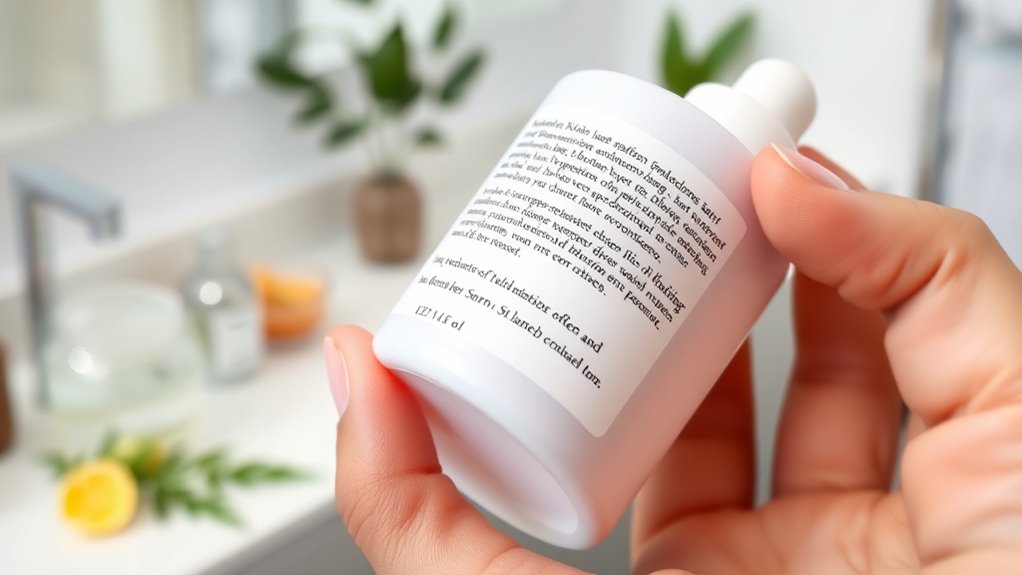
Wondering how to make sense of food labels? Reading ingredient lists can seem overwhelming, but it’s key to identifying harmful additives like parabens, sulfates, and silicones. Here’s how to get started:
- Look for common names and chemical synonyms listed on labels.
- Focus on the first few ingredients—they make up most of the product.
- Watch out for vague terms like “fragrance” or “beauty extract” that hide harmful chemicals.
- Familiarize yourself with ingredient names associated with parabens, sulfates, and silicones.
Alternatives to Parabens, Sulfates, and Silicones
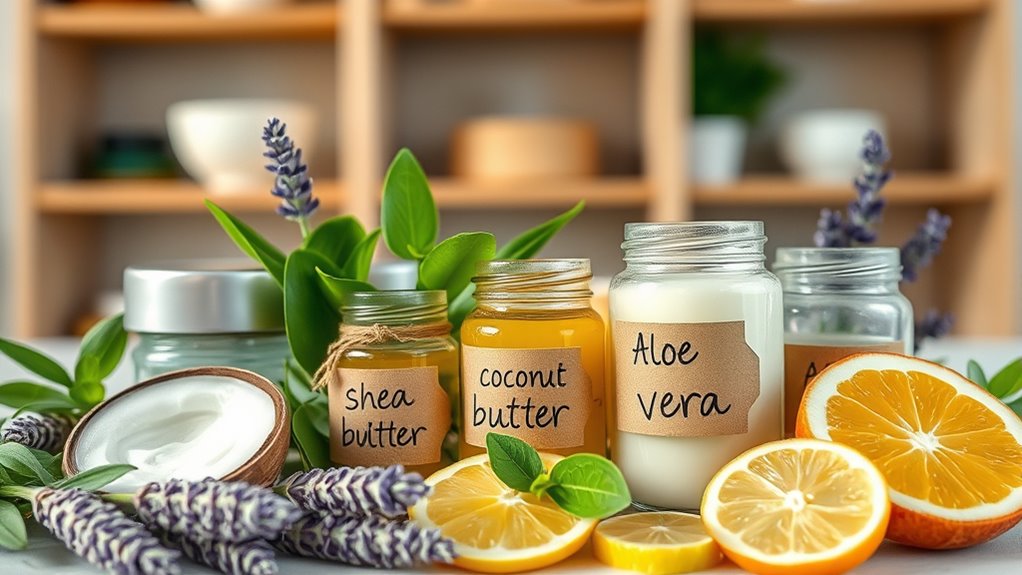
Many brands now offer alternatives to products containing parabens, sulfates, and silicones. You can choose natural alternatives like plant-based oils, herbal extracts, and gentle surfactants that cleanse without stripping your skin or hair. These options often come from brands committed to eco-friendly and cruelty-free practices. If you prefer a hands-on approach, DIY skincare lets you create personalized products using simple ingredients like coconut oil, baking soda, or honey. These natural alternatives are free from harsh chemicals, reducing the risk of irritation and long-term harm. By switching to these options, you support healthier skincare routines and a more sustainable environment. Exploring DIY skincare recipes or selecting brands focused on natural ingredients can make a significant difference in your beauty regimen.
Frequently Asked Questions
Are There Natural Alternatives to Parabens, Sulfates, and Silicones?
Yes, you can find natural alternatives to parabens, sulfates, and silicones. Look for products with natural preservatives like vitamin E or rosemary extract, which help extend shelf life without synthetic chemicals. Opt for plant-based surfactants, such as coco glucoside or decyl glucoside, to gently cleanse without harsh sulfates. These natural ingredients are gentler on your skin and better for the environment.
How Do Parabens, Sulfates, and Silicones Affect Sensitive Skin?
Have you ever felt a burning or itching sensation after using certain products? Parabens, sulfates, and silicones can cause skin irritation for sensitive skin types. They may also disrupt your skin’s pH balance, leading to redness or dryness. If your skin reacts badly, it’s likely these ingredients are to blame. Consider switching to gentle, natural options to protect your skin’s health and maintain its natural barrier.
Can These Ingredients Cause Allergic Reactions?
You might wonder if parabens, sulfates, and silicones can cause allergenic reactions. For some, ingredient sensitivity leads to skin irritation or allergic responses, especially if you have sensitive skin. These substances can trigger allergic reactions in certain individuals. If you notice redness, itching, or swelling after using products with these ingredients, it’s wise to avoid them and consult a dermatologist to prevent further issues.
Are All Products With These Ingredients Unsafe?
Question quivering on your mind: are all products with parabens, sulfates, and silicones unsafe? The truth is, not necessarily. You need to scrutinize ingredient safety and product labeling before making a decision. Some formulations are gentle and safe, while others may cause concerns. So, don’t dismiss all at once—delve into details, read labels carefully, and determine what aligns with your skincare standards. Knowledge keeps you confident!
How Do I Store Products Containing Parabens, Sulfates, and Silicones?
To store products containing parabens, sulfates, and silicones, you should keep them in a cool, dry place away from direct sunlight. Good storage tips include sealing bottles tightly after each use and avoiding bathroom cabinets prone to humidity. Proper storage helps maintain ingredient stability, ensuring your products stay effective longer and prevent potential degradation or contamination. Always check packaging for specific storage instructions to preserve their quality.
Conclusion
By understanding parabens, sulfates, and silicones, you can make smarter choices for your health and the environment. Did you know that over 90% of personal care products contain at least one of these ingredients? Being label-savvy helps you avoid potential risks and find safer alternatives. Empower yourself to choose products that align with your values and well-being, and make a positive impact on both your body and the planet.
